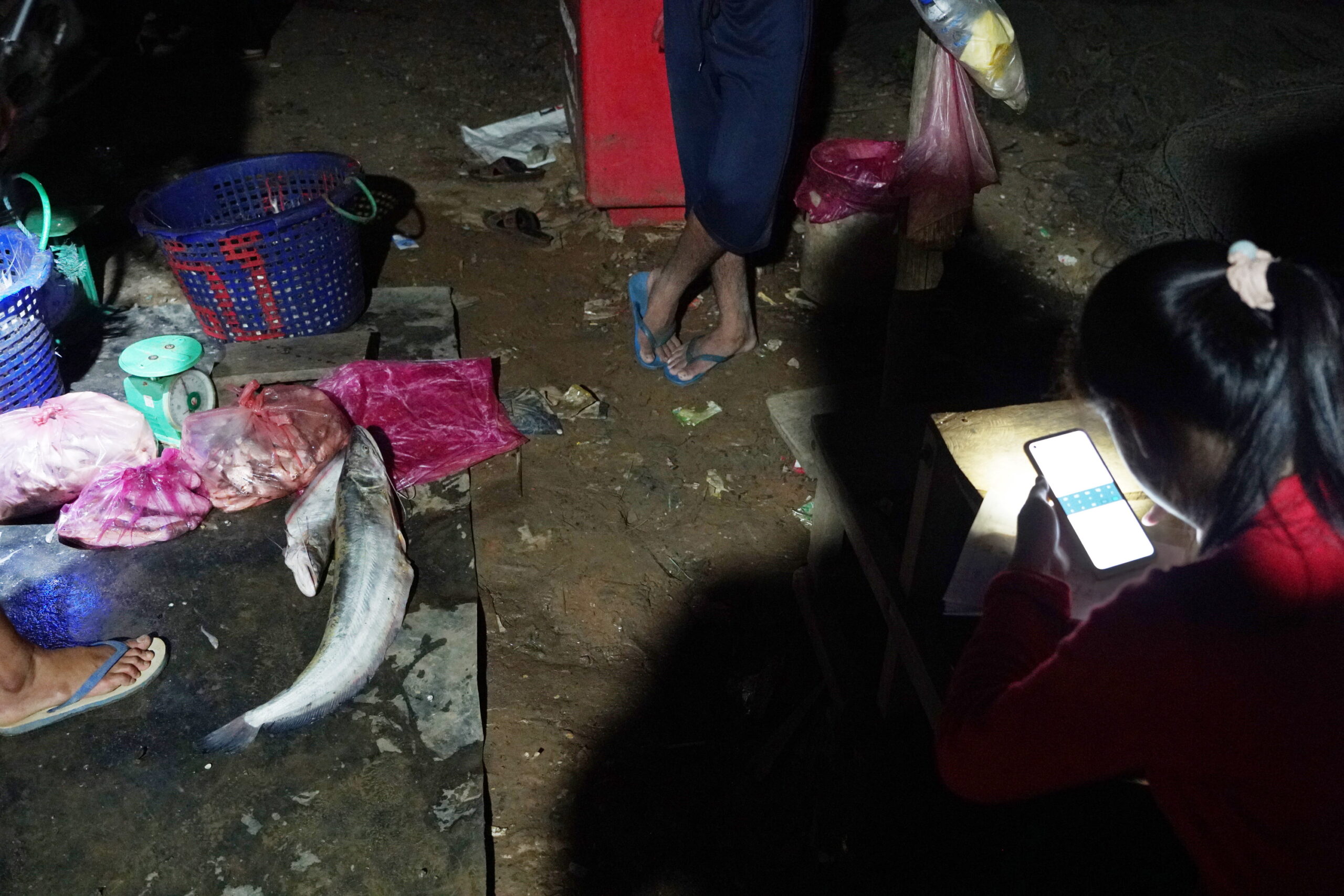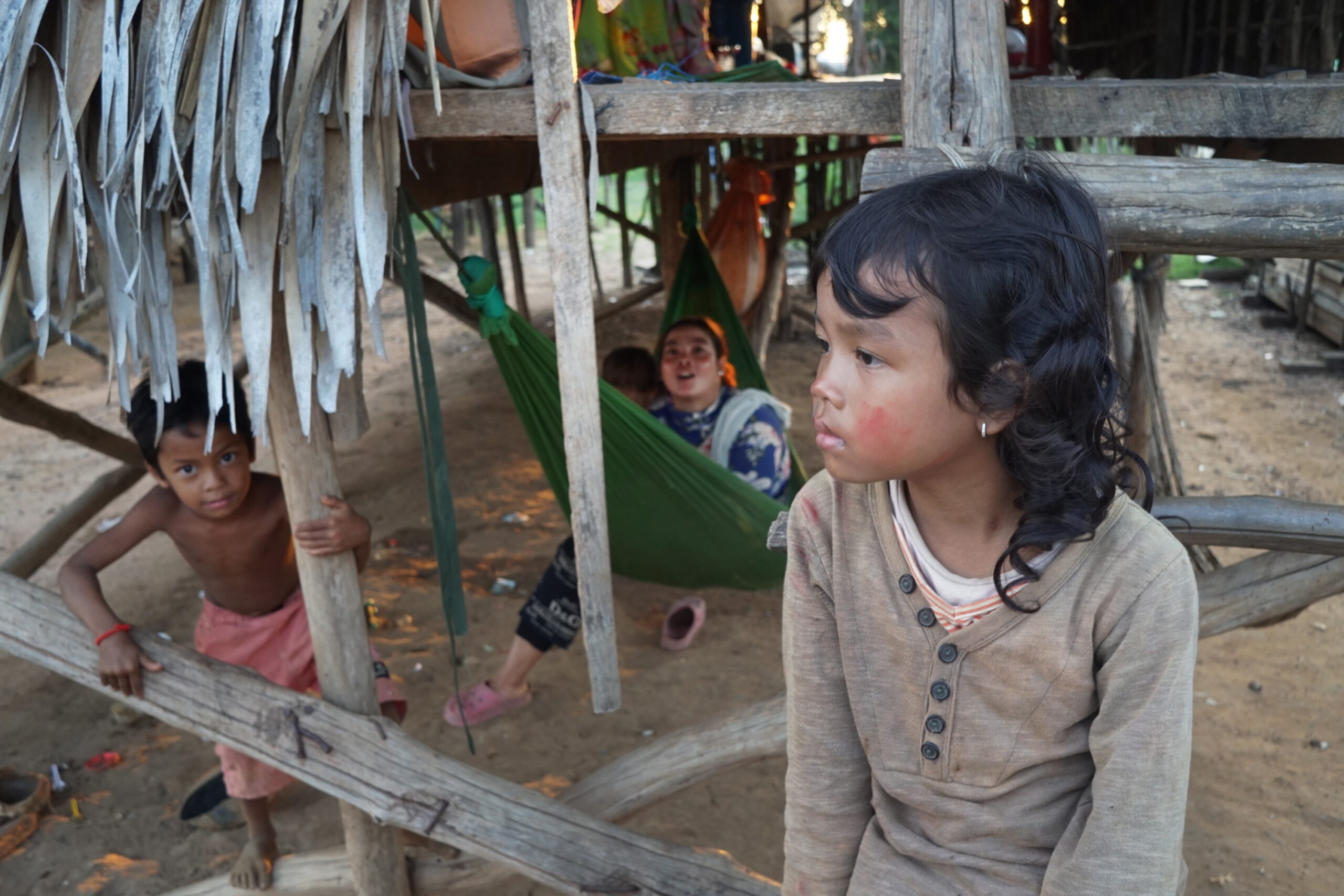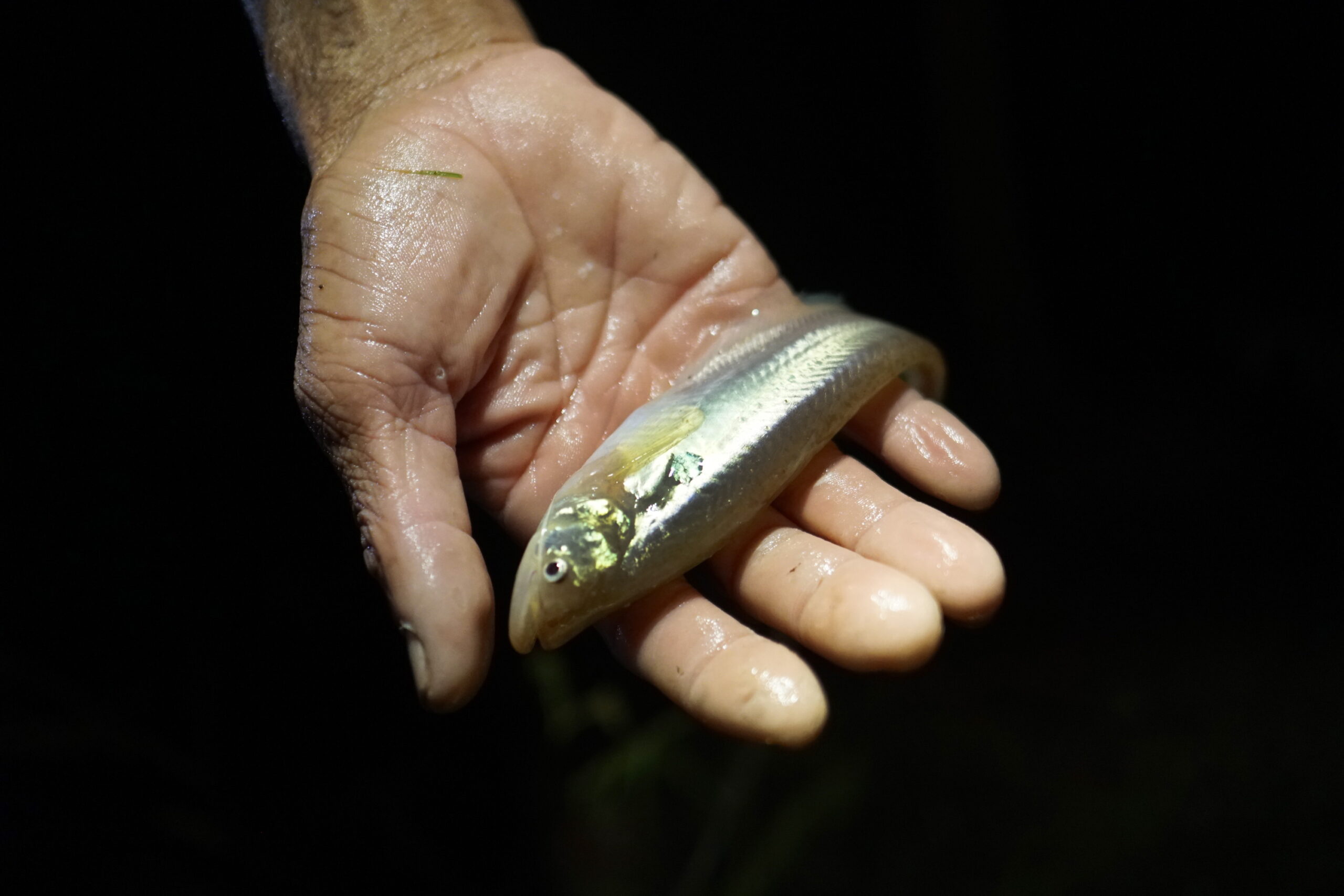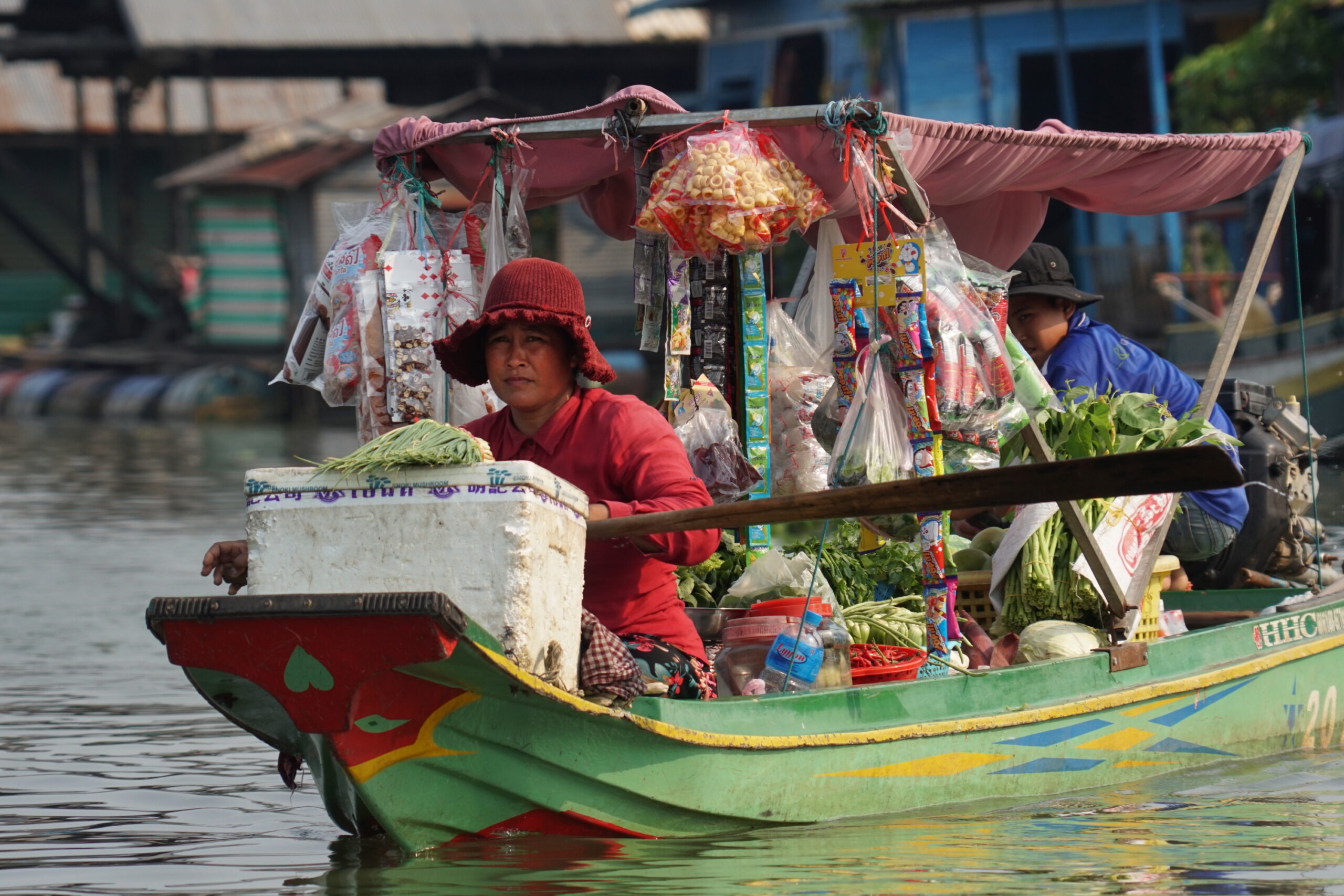Children on Tonle Sap face a hazy future
As fish populations fall on Southeast Asia’s largest freshwater lake, some students are forced to trade books for nets while others look to break tradition with new professions





At dusk in the village of Kompong Phluk, Prak Thina, 16, sorts through fish for her mother, to sell the next morning as fishermen weigh their latest haul.
Prak Thina had just a few minutes to finish her English homework.
As the sky tinged pink, 16-year-old Thina closed her notebook and walked down to the mouth of Tonle Sap Lake a few metres from her grandmother’s store, kneeling down to cull the latest fish haul from big baskets for her mother to sell in the markets the next morning.
Thina is quick with numbers. But she’s not interested in selling fish for a living: She’d like to leave the 4,000-person lakeside community of Kompong Phluk and get a bachelor’s degree.
“When I grow up, I want to be a teacher,” she explained. “I want to teach kids all the stories of our community.”
In Kompong Phluk, two straight rows of houses on stilts faced one another along a newly paved concrete road. At eye level, kids played marbles along the street and under the cover of the homes, where the crisscrossing wooden stilts were strung with hammocks and provided shelter for old boats piled with baskets and cloth. Sacks of rice and salt hung from the rafters.







Prak Thina (top left) and her cousin and neighbour Pen Thina, 15, stand outside their grandmother’s store, where Prak Thina’s father runs a one-room guesthouse on the second floor. With no school scheduled the week before Khmer New Year, kids play marbles on the newly-paved road, while a mother and daughter haul wood for a fire near the high school at the edge of the village. Bottom centre, Chheng Navy, 32, lies in a green hammock beneath her home, which she lacks the funds to repair.
Thina’s 15-year-old cousin, Pen Thida, grew up just two houses away, the homes connected by nimble boards like skyways. Her favourite subjects are English and Khmer, the classes in which she first learned stories of ancient Angkor history.
They weren’t sure whether they wanted to stay in Kompong Phluk, looking at each other in hesitation.
“I don’t know,” Thida said.








After dark, fishermen gather near the riverbanks outside Kompong Phluk, tossing their heavy lead weighted nets into the air before they fall deep into the water. These days, they don’t catch as many as years before. An old man sits under a mosquito net, on the first floor of his stilted home checking his mobile phone.
For the roughly 3 million people living around Cambodia’s largest freshwater lake, climate change, overfishing, drought and mass deforestation have decimated fish populations and left communities like Kompong Phluk – where many families have lived on the water’s edge for three or four generations – without their main source of income.
Young people like Thina and Thida say their futures are hazy: Many don’t want to be fishermen or vendors but are forced to drop out of school to help their parents, while others have tried to open businesses or find construction work away from the water.
Down the street from Thida and Thina’s homes, Tae Sokma, 13, sat surrounded by a gaggle of friends sucking down passion fruit milk and shaking their ice in plastic cups. In the storefront behind them, a woman sold fish fried in sloped pans and sandwiches from a panini press balanced precariously on the makeshift counter. The countertop was lined with rows of Tiger beer, shrimp chimps and litres of Coke.














Kids dance in Kompong Phluk high school grounds during a pre-New Year celebration. A fisherman at the water’s edge untangles his nets, others sort fish under stilt houses. Bottom centre, in Kaoh Kaek, people relax with an afternoon game of cards.
Like all her friends, Sokma’s dad is a fisherman. She wants to live in Kampong Phluk forever, she said: It’s her place. The night before, hundreds of kids crowded in front of the high school at the village entrance to celebrate Khmer New Year, eating ice cream and dancing in a circle to music so loud they had to shout.
But Sokma, who wants to be a doctor, explained the predicament of staying simply: “Ot mean trae, ot mean loy.” (“If there isn’t fish, there isn’t money.”)












In Kaoh Kaet, fisherwoman Van Sophea (bottom right) describes saving 3,000 riel daily to send her kids to school a few minutes away in Prek Toal. In villages around the Tonle Sap, many children take boats both ways to school, adding up to an onerous sum for parents. Net Chhun (top, middle left) sits with Seng Pha as they prepare to eat lunch


At the northern edge of Tonle Sap Lake in the inlet of Kaoh Kaek, 30-year-old Van Sophea sat with her brother and a few of her youngest children on an April afternoon, shading herself from the sun in a floppy pink hat.
Most of the roughly 50 families in Kaoh Kaek can’t afford to live in Prek Toal, the booming river highway just a five-minute boat ride away, and instead make do on the edges of the protected green bird sanctuary.


For Sophea, who lives in a wooden hut near the water with her seven kids, building a larger floating home like her neighbours’ would mean spending roughly $1,000 that the family doesn’t have, she said. On a good day, she earns about eight dollars selling fish to a wholesaler a few houses away; on a bad day it’s just two dollars.
All around the Tonle Sap, parents pay a small fee to ferry their children to school in long, narrow boats. For Sophea, the total is about 3,000 riel a day – 75 cents – for her 12- and 13-year-old to travel to and from the blue floating schoolhouse in Prek Toal.
“They want to work on the land side, in the city,” Sophea said, using the local term for places away from the lake. “They’re smart, they love learning, so I’m trying to continue supporting them to study. They keep asking me to.”
But in reality, many students drop out, especially boys, said 26-year-old teacher Not Sereylich, sitting over a bowl of fish soup as she reviewed English vocabulary with a pupil in Kompong Phluk. In the background, a chorus of youthful voices repeated phrases during a supplemental English lesson hosted underneath the awning of a home.









For the past four years, Sereylich has taught five subjects as a contracted teacher at the blue-and-white, stilted elementary school across the street from the pagoda in the village centre, where nightly soccer games have packed the dirt into hard earth. The majority of her approximately 650 students are girls, she said, because boys so frequently drop out to help their parents as extra boat hands.
“It’s too young – sometimes it’s 12, eight, 14 – when they leave school,” she said.
Those in rural areas consistently fall behind in school compared to kids growing up in Phnom Penh, with just 25% of 15- to 17-year-olds enrolled in secondary school compared to 54% in the capital city, according to a 2020 report by the Cambodian National Institute of Statistics at the Ministry of Planning.
Students might return for a week or two after Sereylich tracks them down at home, but they always drop out again, leaving her with a deep sense of frustration. “They have no choice,” she said.










Chay San, 23 (bottom left) sits with her mother outside the store she opened four years ago in the bustling village of Prek Toal as the Tonle Sap’s fishing supplies dwindled. Even so, business is sometimes “very bad,” she said with a laugh. Others make a living selling groceries (bottom right) or supplement their income selling snacks or petrol to neighbours.


Other young people are taking their futures into their own hands. In the floating village of Prek Toal, a thriving river highway nestled between flooded forests full of protected birds, 23-year-old Chay San sat cross-legged in her festive red storefront.
Four years ago, when fishing proved impossible, she started selling trinkets and food like toy race cars, flowerpots, baseball caps, water jugs, party favours, bottles of soy sauce and condensed milk from her family’s floating home.
Throughout her young adulthood, San said, many neighbours have moved away from the lake to find work in Siem Reap garment factories or labour on per diem construction jobs. But San doesn’t ride a moto or a bicycle and isn’t sure what she would do on land, she said with a laugh.
Plus, she loves teang ah – everything – about running the store, even though business varies.
“Sometimes it’s very bad, sometimes it’s okay,” she said, flip-flopping her hand. “When people don’t make much, they don’t spend much.”










Floating village of Prek Toal, Tonle Sap, Cambodia
On busy days, boats careen up and down the Prek Toal riverway as toddlers paddle in buckets to visit neighbours and bags of salt, chilis and spices sway in a circular motion as they hang from vegetable-laden grocery boats treading from home to home. But recently the village has been quiet as people try to conserve gas, San said. Prices have risen from about 3,500 riel (about 87 cents) per litre of fuel to 5,500 ($1.37) in recent months.






Boats nestled around the curving river at the base of Kompong Khleang, where monks overlook a small fishing lake below the pagoda (bottom right). With stilted houses on the other side of the river, recently caught fish are loaded onto the quayside to be taken away for resale.
About two hours southeast by boat in the village of Kompong Khleang, hundreds of stilted homes, sometimes three stories off the ground, sprawled along curving dirt roads that led up to the waterfront and alongside fingers of water like a spiderweb.


At the far reach of the village, Pom Reksmey, 41, visited his red-and-blue house, dotted with potted plants, for the first time in two months. He arrived from Preah Sihanouk province, best known for the beachside destination of Sihanoukville. Ten years ago, he could fish about 20 kilos (44 pounds) each day; in the past year it’s dwindled to about 5 to 10 kilos (11 to 22 pounds), forcing him to become the first in four generations to leave Kompong Khleang to cut steel as a construction worker.
Reksmey said he missed the friends he grew up with, sitting together in the evenings and unwinding with a drink. On a good fishing day he made more than double his $12 daily construction wage, and he still needed to pay back half of the $4,000 he borrowed to build the family’s house. Even with the bank loan, they had to settle for a cheap metal roof.
Despite a steadier income, moving away from home wasn’t enough to scrape together school fees for his four kids, all of whom are under 15. “We have no money to support them,” he said. For the first time this year, Reksmey’s two oldest children dropped out.
The second part of the two-part series on life and livelihood around the Tonle Sap can be found here.

